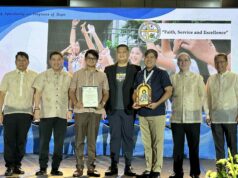WE ARE a Foundation committed to Save Pampanga; to preserve, develop and promote the Kapampangan “body” and “soul.”
Theirs is the noblest of missions. We are the lead organization that aims to showcase the multi-faceted practices and traditions of Kapampangan Culture and Heritage.
Theirs is the clearest of visions. So it was to that end that the Foundation for Lingap Kapampangan Inc. (FLKI) – in its earlier incarnation as the Save Pampanga Movement – birthed the Sinukwan Festival in 1998, in the immediate aftermath of the Mount Pinatubo eruptions when the province faced literal obliteration from the face of the earth, when its people were confronted with a diaspora that would inevitably lead to the dissipation of their culture as a race.
Named after the legendary Kapampangan demigod Aring Sinukwan who had Mount Arayat for his Mount Olympus, the festival served as a rallying point for the people to draw from the strength of the Kapampangan character to survive the devastation, rise over it, and soar to even new levels of development a la the mythical phoenix.
Which, ultimately, they did. Sinukwan has since become the signature festival of the province. Not that the province has ever been bereft of celebrations of its arts, its culture and its traditions. But that pre-Sinukwan, the festivals staged failed to attract outside the municipal boundaries, and numbered less than the fingers of one hand.
Let’s see now…Aguman Sanduc in Minalin, Kuraldal in Sasmuan, the Giant Lantern in San Fernando…
Apres Sinukwan, more aptly now, Sinukwan spawned – not in chronological order – Ibon- Ebon in Candaba, Caragan in Mabalacat, Makatapak in Bacolor, Binulu in Porac, Sabuaga in Sto. Tomas, Duman in Sta. Rita, Tugak in San Fernando, Sisig in Angeles, Sampaguita in Lubao, Mais in Mexico…
All these in celebration of the best of the Kapampangan in arts and crafts, in cuisine, in products, in culture. And our festive flair continues. Last Saturday, preparations for the 17th Sinukwan Festival officially commenced with the signing of a memorandum of agreement between the FLKI and Robinsons Land Corp., whereby the latter, as premier sponsor, handed over P1.5 million to the former.
Themed Tetagan at Kapagsadian… Kasiguraduan Ning Kulturang Kapampangan (Steadfastness and Readiness…Ensuring Kapampangan Culture – my literal translation), this year’s edition, slated from Nov. 28 to Dec. 6, comprised its usual menu of pageants – Mutya, Lakan, Prinsesita ning Sinukwan; culinary delights in Pyestang Pamangan Kapampangan; craft fair including couture in Gayak at Piblas; music and dance in a Kapampangan variety show, in drum and lyre competition, SingNuk1 Idol, streetdancing and free interpretative dance competition.
Then, there listed too is a Kapampangan Hip-Hop Competition. All the other events I can easily relate to Kapampangan culture. The Mutya-Lakan pageants but a celebration of the Pampanguena character of malagu (beautiful), mahinhin (modest), and matimtiman (charming) to Pampangueno’s masikan (strong), matapang (brave) and masipag (hardworking), as very well articulated in a paper by my esteemed kin, Dr. Evangelina H. Lacson.
Food? Pampanga is the country’s culinary capital. Couture? Ain’t the Philippines’ best dressed the Kapampangan?
Music? A part of our Filipino soul. Dance? We are born to it, why, even religious celebrations are not spared from it.
But Kapampangan Hip-Hop? Whose brilliant idea is it to include this in the Sinukwan fest? For what purpose? As a compromise to some misguided misconception of modernity? It just ain’t right.
For one, Kapampangan Hip-Hop is a contradiction in terms defining an impossibility, aye, a blasphemy – the letter H is non-existent in the Kapampangan language. More seriously, what has the Kapampangan soul got to do with a music genre that is putatively, if not patently, African-American in origin?
Indeed, why go hip-hop when the Kapampangan has his own “stylized rhythmic music that commonly accompanies…a rhythmic and rhyming speech that is chanted” long, looong, looooong before hip hop came to the scene?
We have our own polosa and basulto that are definitively Kapampangan and definitely superior to hip hop. To cite the culturatus and literatus Robby Tantingco of the Center for Kapampangan Studies: “Polosa is a tribute; thus, a polosador is someone who sings in honor of a birthday celebrator, a guest of honor, a guest speaker, or a newly crowned beauty queen.
The polosa is sung extemporaneously, and this is where the genius of a polosador comes out: all he needs to do is take a quick look at the honoree, or get a quick interview with him, and the next moment he is already singing praises to his looks and his accomplishments in life.
“Basulto, on the other hand, refers to all Kapampangan songs sung with a fast beat, similar to the yodelling style of Fred Panopio (who is a Kapampangan from Bacolor) and to ditties performed by guitar-toting door-to-door beggars; papalatuk la tonu is a good description.
“The word polosa is probably a corruption of prosa, or prose, which is the opposite of poesiya, or poetry. In the early days, people considered poetry “the language of angels” and prose “the language of men,” i.e., appropriate for the masses, not for the upper class.”
Hip hop is then an alien adjunct that can only adulterate, if not maculate, the purity of our culture. Indeed, an infected virus inflicted upon the Kapampangan soul. As things go now, polosa and basulto are dying, practised only by the correspondingly dying breed of Totoy Bato and his handful wannabes, Bong Manalo, and Totoy Balas.
Hip hop is the last thing we need to finally consign those distinctively Kapampangan music genres to extinction.
That will be a great disservice to our people, a betrayal of our race, coming as it is in the hands of those who have taken upon themselves to be the very custodian of the Kapampangan soul.
Sad.




